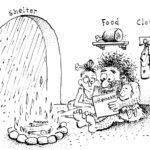GRAMMAR/USAGE
The Parts of Speech
The first family of grammar

The parts of speech are the eight different categories that a word or phrase can be grouped into, based on the grammatical function it is carrying out in a sentence, phrase, or clause.
If you are not as yet on a first-name basis with the parts of speech (quick test: do you know the difference between an adjective and an adverb?) this tutorial will serve you well as a starting point in your efforts to master the basics of English grammar—and for the following reason: Virtually every rule relating to grammar, sentence structure, and word choice includes the name of at least one (and often more than one) part of speech.
ZEROING IN
The eight parts of speech in English are the following:
- nouns
- pronouns
- verbs
- adjectives
- adverbs
- prepositions
- conjunctions
- interjections
NOUNS
Grammatical function: To name a person, place, thing, or activity.
You can’t teach an old dog (the name of an animal) new tricks (the name of an activity).
You can catch more flies (the name of an insect ) with honey (something you can taste) than with vinegar (something else you can taste).
You can’t fit a round peg (a small piece of wood) into a square hole (an opening).
PRONOUNS
Function: To take the place of and refer back to a noun. Common examples include “I”, “you”, “he”, “she”, “they”, “this”, “it”, “its”, and “whose”.
Cowards die many times before their (takes the place of and refers back to the noun “cowards”) deaths.
A leopard cannot change its (replaces and refers back to the noun “leopard”) spots.
If a job is worth doing, it (replaces and refers back to the noun “job”) is worth doing well.
Reminder: The grammatical term for the word or group of words being replaced and referred to is “antecedent”.
VERBS
Functions: (1)To express an action; (2) to connect a noun or noun phrase to a word or group of words that completes the thought partially formed by the subject.
Birds of a feather flock (an action) together.
The proof of the pudding is (links “pudding” to an activity: “in the tasting”.)
A stitch in time saves (an action) nine.
A picture is (“links” the noun “picture” to “worth a thousand words.”)
When one door shuts an action, another door opens (an action).
Reminder: Verbs express what the subject “does” or “is”.
ADJECTIVES
Function: To expand the meaning of nouns by answering one or more of the following three questions: What kind?, How many?, or Which ones?
The squeaky wheel gets the grease. (“Squeaky” modifies the noun “wheel”, and answers the question “Which kind of a wheel gets the grease?).
People who live in glass houses shouldn’t throw stones. (“Glass” expands the meaning of the noun “houses”)
The early bird catches the worm. (“Early” answers the question “Which bird gets the worm?)
ADVERBS
Function: To expand the meaning of verbs, adjectives, and other adverbs. They answer one or more of the following questions: “When?”, “Where?”, “How?”, “To what extent?, “How much?
Time passes quickly when you’re having fun. (“Quickly” answers the question “How does time pass when you are having fun? )
Power corrupts, and absolute power corrupts absolutely. (“Absolutely” modifies the verb “corrupts”.)
Speak softly but carry a big stick. (“Softly” answers the question “How should you speak when you are carrying a big stick?)
CONJUNCTIONS
Function: To connect words, phrases, and sentences. The most common conjunctions are “and”, “or”, “but”, “because”, “for”, if, and when
You can’t have your cake and eat it, too. (“And” connects “cake” and to “eat it too”.)
Sticks and stones (“And” connects “sticks and stones”) can break your bones, but names can never hurt you. (“But” connects “bones” and “names”.)
Time and tide wait for no man. (“and connects “time” and “tide”).
PREPOSITIONS
Function: To connect and show the relationship between nouns, pronouns, verbs or adjectives and other words in the same sentence.
Never look a gift horse in the mouth (“In” connects and shows the relationship between “gift horse” and “mouth”.).
It is always darkest before the dawn. (“Before” connects “darkest” to “before the dawn”.)
The apple doesn’t fall far from the tree. (“From” shows the relationship between “far” and “tree”.)
INTERJECTIONS
Function: To express a strong feeling or an enthusiastic reaction. They can stand alone in a sentence or be followed by a comma.
Wow! That was some game we saw last night!
I just heard about your promotion. Bravo!